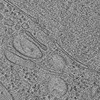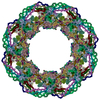[English] 日本語
 Yorodumi
Yorodumi- EMDB-52054: Cryo-tomogram of Dictyostelium discoideum cell - hyperosmotic str... -
+ Open data
Open data
- Basic information
Basic information
| Entry |  | ||||||||||||
|---|---|---|---|---|---|---|---|---|---|---|---|---|---|
| Title | Cryo-tomogram of Dictyostelium discoideum cell - hyperosmotic stress condition (+0.4 M sorbitol), related to Figure 1b | ||||||||||||
 Map data Map data | cryo-tomogram D.discoideum - hyper OS, tomogram 029 | ||||||||||||
 Sample Sample |
| ||||||||||||
 Keywords Keywords | in situ tomogram / nuclear pore complex / hyperosmotic stress / NUCLEAR PROTEIN | ||||||||||||
| Biological species |  | ||||||||||||
| Method | electron tomography / cryo EM | ||||||||||||
 Authors Authors | Hoffmann PC / Kim H / Obarska-Kosinska A / Kreysing JP / Andino-Frydman E / Cruz-Leon S / Margiotta E / Cernikova L / Kosinski J / Turonova B ...Hoffmann PC / Kim H / Obarska-Kosinska A / Kreysing JP / Andino-Frydman E / Cruz-Leon S / Margiotta E / Cernikova L / Kosinski J / Turonova B / Hummer G / Beck M | ||||||||||||
| Funding support |  Germany, European Union, 3 items Germany, European Union, 3 items
| ||||||||||||
 Citation Citation |  Journal: Mol Cell / Year: 2025 Journal: Mol Cell / Year: 2025Title: Nuclear pore permeability and fluid flow are modulated by its dilation state. Authors: Patrick C Hoffmann / Hyuntae Kim / Agnieszka Obarska-Kosinska / Jan Philipp Kreysing / Eli Andino-Frydman / Sergio Cruz-León / Erica Margiotta / Lenka Cernikova / Jan Kosinski / Beata ...Authors: Patrick C Hoffmann / Hyuntae Kim / Agnieszka Obarska-Kosinska / Jan Philipp Kreysing / Eli Andino-Frydman / Sergio Cruz-León / Erica Margiotta / Lenka Cernikova / Jan Kosinski / Beata Turoňová / Gerhard Hummer / Martin Beck /  Abstract: Changing environmental conditions necessitate rapid adaptation of cytoplasmic and nuclear volumes. We use the slime mold Dictyostelium discoideum, known for its ability to tolerate extreme changes in ...Changing environmental conditions necessitate rapid adaptation of cytoplasmic and nuclear volumes. We use the slime mold Dictyostelium discoideum, known for its ability to tolerate extreme changes in osmolarity, to assess which role nuclear pore complexes (NPCs) play in achieving nuclear volume adaptation and relieving mechanical stress. We capitalize on the unique properties of D. discoideum to quantify fluid flow across NPCs. D. discoideum has an elaborate NPC structure in situ. Its dilation state affects NPC permeability for nucleocytosolic flow. Based on mathematical concepts adapted from hydrodynamics, we conceptualize this phenomenon as porous flow across NPCs, which is distinct from canonically characterized modes of nucleocytoplasmic transport because of its dependence on pressure. Viral NPC blockage decreased nucleocytosolic flow. Our results may be relevant for any biological conditions that entail rapid nuclear size adaptation, including metastasizing cancer cells, migrating cells, or differentiating tissues. | ||||||||||||
| History |
|
- Structure visualization
Structure visualization
| Supplemental images |
|---|
- Downloads & links
Downloads & links
-EMDB archive
| Map data |  emd_52054.map.gz emd_52054.map.gz | 311.4 MB |  EMDB map data format EMDB map data format | |
|---|---|---|---|---|
| Header (meta data) |  emd-52054-v30.xml emd-52054-v30.xml emd-52054.xml emd-52054.xml | 9.6 KB 9.6 KB | Display Display |  EMDB header EMDB header |
| Images |  emd_52054.png emd_52054.png | 259 KB | ||
| Filedesc metadata |  emd-52054.cif.gz emd-52054.cif.gz | 4 KB | ||
| Archive directory |  http://ftp.pdbj.org/pub/emdb/structures/EMD-52054 http://ftp.pdbj.org/pub/emdb/structures/EMD-52054 ftp://ftp.pdbj.org/pub/emdb/structures/EMD-52054 ftp://ftp.pdbj.org/pub/emdb/structures/EMD-52054 | HTTPS FTP |
-Validation report
| Summary document |  emd_52054_validation.pdf.gz emd_52054_validation.pdf.gz | 533.3 KB | Display |  EMDB validaton report EMDB validaton report |
|---|---|---|---|---|
| Full document |  emd_52054_full_validation.pdf.gz emd_52054_full_validation.pdf.gz | 532.8 KB | Display | |
| Data in XML |  emd_52054_validation.xml.gz emd_52054_validation.xml.gz | 5.1 KB | Display | |
| Data in CIF |  emd_52054_validation.cif.gz emd_52054_validation.cif.gz | 6.2 KB | Display | |
| Arichive directory |  https://ftp.pdbj.org/pub/emdb/validation_reports/EMD-52054 https://ftp.pdbj.org/pub/emdb/validation_reports/EMD-52054 ftp://ftp.pdbj.org/pub/emdb/validation_reports/EMD-52054 ftp://ftp.pdbj.org/pub/emdb/validation_reports/EMD-52054 | HTTPS FTP |
-Related structure data
- Links
Links
| EMDB pages |  EMDB (EBI/PDBe) / EMDB (EBI/PDBe) /  EMDataResource EMDataResource |
|---|
- Map
Map
| File |  Download / File: emd_52054.map.gz / Format: CCP4 / Size: 378.1 MB / Type: IMAGE STORED AS SIGNED BYTE Download / File: emd_52054.map.gz / Format: CCP4 / Size: 378.1 MB / Type: IMAGE STORED AS SIGNED BYTE | ||||||||||||||||||||
|---|---|---|---|---|---|---|---|---|---|---|---|---|---|---|---|---|---|---|---|---|---|
| Annotation | cryo-tomogram D.discoideum - hyper OS, tomogram 029 | ||||||||||||||||||||
| Voxel size | X=Y=Z: 8.704 Å | ||||||||||||||||||||
| Density |
| ||||||||||||||||||||
| Symmetry | Space group: 1 | ||||||||||||||||||||
| Details | EMDB XML:
|
-Supplemental data
- Sample components
Sample components
-Entire : Cryo-tomogram of cryo-FIB milled D. discoideum cell under hyperos...
| Entire | Name: Cryo-tomogram of cryo-FIB milled D. discoideum cell under hyperosmotic stress |
|---|---|
| Components |
|
-Supramolecule #1: Cryo-tomogram of cryo-FIB milled D. discoideum cell under hyperos...
| Supramolecule | Name: Cryo-tomogram of cryo-FIB milled D. discoideum cell under hyperosmotic stress type: cell / ID: 1 / Parent: 0 |
|---|---|
| Source (natural) | Organism:  |
-Experimental details
-Structure determination
| Method | cryo EM |
|---|---|
 Processing Processing | electron tomography |
| Aggregation state | cell |
- Sample preparation
Sample preparation
| Buffer | pH: 7.2 |
|---|---|
| Vitrification | Cryogen name: ETHANE |
| Details | Hyperosmotic stress in HL5 + 0.4M sorbitol applied for approx. 1 min prior to plunge freezing |
| Sectioning | Focused ion beam - Instrument: OTHER / Focused ion beam - Ion: OTHER / Focused ion beam - Voltage: 30 / Focused ion beam - Current: 0.03 / Focused ion beam - Duration: 3600 / Focused ion beam - Temperature: 91 K / Focused ion beam - Initial thickness: 5000 / Focused ion beam - Final thickness: 150 Focused ion beam - Details: for details please see material and methods section of the paper. The value given for _em_focused_ion_beam.instrument is TFS Aquilos2 cryo-FIB/SEM. This is not in a list ...Focused ion beam - Details: for details please see material and methods section of the paper. The value given for _em_focused_ion_beam.instrument is TFS Aquilos2 cryo-FIB/SEM. This is not in a list of allowed values {'OTHER', 'DB235'} so OTHER is written into the XML file. |
- Electron microscopy
Electron microscopy
| Microscope | TFS KRIOS |
|---|---|
| Image recording | Film or detector model: GATAN K3 BIOQUANTUM (6k x 4k) / Average electron dose: 2.3 e/Å2 |
| Electron beam | Acceleration voltage: 300 kV / Electron source:  FIELD EMISSION GUN FIELD EMISSION GUN |
| Electron optics | Illumination mode: FLOOD BEAM / Imaging mode: BRIGHT FIELD / Nominal defocus max: 5.0 µm / Nominal defocus min: 2.5 µm |
| Experimental equipment |  Model: Titan Krios / Image courtesy: FEI Company |
- Image processing
Image processing
| Final reconstruction | Details: alignment with patch-tracking and reconstruction in etomo, bin4 backprojection with SIRT-like filtering Number images used: 59 |
|---|
 Movie
Movie Controller
Controller




































